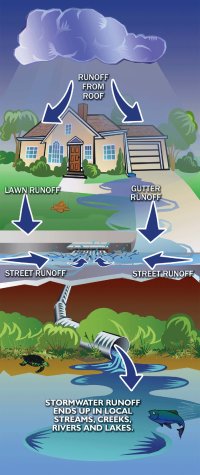What Is Stormwater Runoff?
Stormwater runoff can be loosely defined as rain that hits the ground and then eventually finds its way to the nearest water body. On the ODU campus, stormwater falls on buildings, roads, parking lots, sidewalks, loading docks, and landscaped areas. Some of it soaks into the ground, but most of it flows to the nearest storm drain.
Where are the storm drains, and where do they go?
You'll see these storm drains everywhere - along roads, in parking lots, near buildings. Some are round, some are square. Most are marked with a ODU placard that says "Only Rain Down the drain". All of these drains connect to pipes underground that then carry the water straight (more or less) to the nearest water body.
Stormwater Runoff Problems
Urban storm water runoff in general has been identified as a major problem for water quality nationwide. Urbanization alters the infiltration capability of soil. Instead of forests and meadowlands, we now have rooftops, roads, and parking lots with virtually no ability to absorb stormwater. The resulting stormwater flows are higher in volume.
Stormwater also suspends and transports pollutants on those surfaces. It is important that we keep as much of those pollutants out of the storm water as possible. The main concerns on campus are oil, sediment, nutrients (phosphorus and nitrogen), heavy metals, toxic chemicals and garbage.
What Can I Do?
Here is a list of things that you can do to minimize your impact on stormwater while on campus (or anywhere you are):
- Provide input on ODU's MS4 Prgram Plan: ehsdept@odu.edu
- Do not litter (even cigarette butts)
- Do not rinse or clean items over/near drains.
- Do not dump any chemicals (even soapy water) down a storm drain - "Nothing but rain down the drain".
- Ensure that your car does not leak oil or gasoline (or consider alternatives to driving)
- Clean up your Pet waste. Toss it in a trash can or flush down toilet.
Report a Spill
If you see a spill on campus and it looks like it will reach a storm drain, call EH&S at 683-4495 during business hours. EH&S appreciates any help with identifying problems, and your call can be anonymous.
Outdoor Cleaning Projects
Only rain may go down the storm drain. Even "biodegradeable" cleaners are not allowed. Excessive sediment should also not be washed into the storm drain. The storm drain delivers water and any pollutants straight to the nearest water body (Chesapeake Bay, Elizabeth River).
The waste water must instead be collected and either discharged to sanitary sewer or disposed of as hazardous waste.



